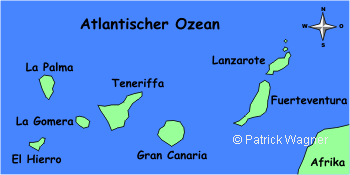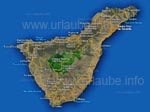|
|
General information of Tenerife
There is hardly another island that attracts each year so many tourists to visit it like Tenerife. Each week, approximately 100.000 tourists land on the island, this is more than 5 millions per year; Why do so many people feel like traveling to Tenerife? Is this due to the eternal spring time that is dominant in Tenerife? Is this due to the temperatures, that in the summer time seldom exceed 30°C and in the winter they fall equally seldom under 20°C? Is this due to the 220 sunny days that delights the island every year? Or is it the nearly unrivaled diversion that one can get in the island? 
Many people call Tenerife the bath tube of Europe or the island of joy. Who are those blessed, these millions of tourists that spend every year their holiday there, the 700.000 inhabitants that live in this paradise during the whole year, or the countless retired people that chosed Tnerife as their residence for their evening of life? The name Tenerife means, in the language of the guanchic aborigines something like mountain covered with snow. Of course, the Teide is meant with this, that is the highest mountain of Tenerife, of the Canarian Islands and even whole Spain with a height of 3718 m. With this, it becomes obvious why the spaniards call Tenerife as an island that is born from the fire. 
Why is Tenerife an island of great opposites? In the mornings, one can lie perspiringly in the sun in one of the many beaches, whereas at noon time, one is cold at a height of 3,000 metres and gazes at the Teide that is covered with snow. On a four laned motorway, one can drive to the capital Santa Cruz de Tenerife and gaze at the modern big city life. Only two hours further up to the Teno mountains, one has the feeling to be nearly alone on a desert island. The weather can be also opposed: At normal north-east weather conditions marvelous sunshine, whereas in the north-east, there are big clowds over the island that even cause rain. In the south west of the island it is respectively dry, whereas in the north east, the colourful fauna flourishes. The origin of TenerifeToday, Tenerife is a big island with a giant volcano in the center. The surface of the island is about approximately 2000 km². It appears that this huge volcano named Teide has lifted the island form the seafloor in a powerful eruption. But it wasn't so: millions of years ago, there were three little islands instead of Tenerife: The Teno mountains in the north west of the island, the Anaga mountains in the north east, as also the southern tip were three separated islands. Two million years ago, a powerful volcano eruption led the three islands together. The Caņadas del Teide, the national park of these days with the Teide in the centre, was originated. The Teide itself is relatively young: not until 500 years ago, the primal Teide was originated by a big eruption, and it was more than 3000 metres high; Approximately 170.000 years ago, it slipped during a powerful rockfall at the northern side of the island into the sea and caused an enormous tsunami (giant tidal wave). Not until after this ferocious natural disaster, the Teide was originated like we know it today, bit by bit. In countless eruptions, it worked itself forward, coat by coat until it had a height of 3718 metres. The volcanic activity of the Teide and/or the island of Tenerife is still not extincted. The last vulcanic eruption in the island took place in the year 1909 close to the little place Santiago del Teide. Around the island, one finds more than 100 little volcanos spread with a height of several hundred metres. The history of TenerifeThe indigenous people of Tenerife are called the guanchics. They lived until the beginning of the 16th century on the island under neanderthal conditions. In the middle of the 15th century, the spaniards started to conquer the island in many conquering expeditions. The resistance of the guanchics lasted for a long time; not until the year 1496, Tenerife was definetely conquered by Alonso de Lupo. Many indigenous people paid the resistance with their lifes; those who survived the Spanish conquer were radicaly supressed and sold as slaves. The spaniards made La Laguna to be the capital of the whole archipielago. A merciless depletion of the nature began; Numerous forests were digged up and sugarcane was cultivated. Therewith, it was possible to make some money in the first half of the 16th century. The wood of the forests was very useful for the building of vessels, as the Canarian Islands became to be the most important intermediate stations for all vessels that crossed the Atlantic in direction to America. As the vessels that were returning from South America were loaded with valuable treasures, there were increasing assaults of the pirates at the coasts of Tenerife in the 16th and the 17th century. Also the English navy tried several times to conquer Tenerife. In the year 1797, the famous Admiral Nelson was put to rout. The commerce of Tenerife suffered a lot of damage by the assaults and the acts of war; intermittently, it even was completely disrupted. In the year of 1822, Santa Cruz de Tenerife was named as the capital; 1852, the Queen Isabel II. awarded the Canarians the status of a free trade zone. Whereas in the beginning of the 19th century, Tenerife decayed into poverty and numerous inhabitants had to leave the island, the economy of Tenerife prospered at the end of the 19th century due emerging banana cultivation and exports. A sad date in the history of Tenerife is the 17th July 1936: the Spanish military governour executes from Tenerife a military putsch against the Spanish government in Madrid and starts the civil war that last three years and where more than 800.000 people died.General Franco came off the civil war as the winner in the year 1939 and established in Spain the military dictatorship that last until 1971. In the sixties, Tenerife experiences an accelerated prosperity due to the setting mass tourism. When in the year 1986 Spain became an EU member, the decadence of the banana trade started, as is could not compete any longer with the cheap imports of South America. Meanwhile, the tourism is long ago the main economic factor of the island. Millions of holidaymakers visit Tenerife every year. Plants, animals and natureI already mentioned the great oppposites that one comes upon in Tenerife. Contrasting and/or diversed is also the vegetation and the nature of the island. Today, the most precious good of Tenerife is the water, especially in the dry south. It seems not to be true, but a little more than five hundred years ago, Tenerife was covered by big and green forests; everywhere, the rivers were spluttering down the mountains. It is hard to believe that in many canyons of the island there once huge water masses were flowing in direction to the sea. What has happened in the last 500 years? When the spaniards conquered Tenerife at the end of the 15th century, an inexcusable assault started against the humans and the nature. The indigenous people were brought under and the main part of them were killed. The laurel and pine forests were deforested in favour of the sugarcane fields. In the medieval times, it was possible to earn a lot of money with sugarcanes. As Tenerife was additionally an important intermediate stop for the vessels with a transatlantic route, a lot of wood was needed for the building of vessels; Erosions of enormous dimensons onset. Today, only in the very centre of the island there are some laurel and pine forsts. There are only laurel forests in the Canarian Islands, Azores, Cape Verde Islands and Madeira. In the course of the years, the Canarian pine tree became fire resistant, as the Canarian Islands were repeatedely afflicted by forest fires. In the national park of the Theide, there are plenty of these pine trees. In the region of the highlands of the Teide, these trees do not grow anymore. Under the extreme climatic conditions, the Teide gorse with its intensive white blossoms developed. From the end of April, the tanigasts (palm trees) that grow up to a height of 2,5 metres, blossom in the highland region. While the fauna of Tenerife is diversified and colourful, the fauna is quite poor. Most of the farm animals were brought into the island by the people. Which animal is the most famous one of the island or, in general, of the Canarian Islands? Of course, it is the canary bird. With a little luck, one can set eyes on a specimen of the tiny bird. I have seen one in the dragon tree park in Icod de los Vinos. More frequently than the canary bird, it is possible to catch sight of the Canarian lizard in all regions of the island. As a hiker, sometimes one even gets affright if, all of a sudden, such a little animal emerges of a rock face. The probably most beautiful animal of the Canarian Islands is the brimstone butterfly that can be sometimes seen during the walking-tours. When I was a child, those yellow butterflies flew galore around me; today, the brimstone butterflies and/or butterflies in general are practically extincted in central Europe. Copyright: Patrick Wagner, www.tourist-guide.biz |
||
